Genealogy
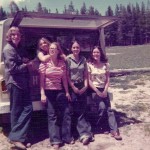
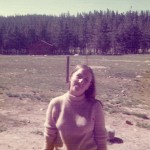 Sometimes, there is such a clear family resemblance that even years after the children are grown, people who knew one of them can tell that another one is a sister. That happened to me when a church camp friend of my sisters, Caryl Reed, Alena Stevens, and Allyn Hadlock, saw me in the mall and asked me if I was their sister. I did not know this man, but he knew them and knew that I bore a definite resemblance to them. I don’t know exactly how often that happens, but my guess is that it maybe happens more than we are aware of. I think many times, people don’t say anything about it. Maybe they are not sure the person is who they think they are, or maybe they aren’t sure the person will remember them. That is sad really, because you never know when you might just make someone’s day, because you remembered them.
Sometimes, there is such a clear family resemblance that even years after the children are grown, people who knew one of them can tell that another one is a sister. That happened to me when a church camp friend of my sisters, Caryl Reed, Alena Stevens, and Allyn Hadlock, saw me in the mall and asked me if I was their sister. I did not know this man, but he knew them and knew that I bore a definite resemblance to them. I don’t know exactly how often that happens, but my guess is that it maybe happens more than we are aware of. I think many times, people don’t say anything about it. Maybe they are not sure the person is who they think they are, or maybe they aren’t sure the person will remember them. That is sad really, because you never know when you might just make someone’s day, because you remembered them.
My family has been blessed with some beautiful people. From aunts, uncles, cousins, siblings, nieces and nephews, as well as grandchildren, they are handsome, and beautiful inside and out. I think that is part of what makes them someone people remember. This was pointed out to my Aunt Sandy Pattan a while back, when she was at Kmart. They were having a Blue Light Special, and she was waiting in line while her things were marked down. Two ladies on the other side of the Blue Light were talking, and obviously looking at my Aunt Sandy. She started to become a little nervous, wondering what was wrong with the way she looked. We always think the worst, don’t we? Once the ladies had finished getting their things marked, they came over to Aunt Sandy, and one of them asked, “Are you one of the Byer girls?” Aunt Sandy said that she was, and the woman said to her friend, “See!! I told you so!!” Aunt Sandy was as surprised as I had been with my encounter, but I think she was right when she said that it isn’t just a person’s looks that makes them memorable, but rather who they are inside. Like my own parents, my grandparents had taught their children to be kind, generous, and thoughtful, and these traits are always remembered, and they make you remember their face too, even if it has changed some over the years.
Sometimes, you can see a person who may or may not be related to someone you liked, but looks like them 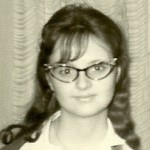
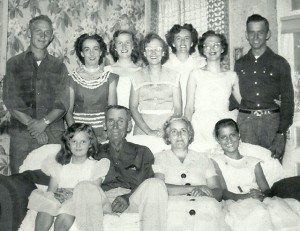 anyway. Whether you ever find out if that person is a relative or not, you still have that nice memory of that person you knew. Of course, family resemblances are always there, but are not always remembered, unless the person stood out in some way. The memory goes a long way if the person was nice to you at some point. Really, who would want to remember someone who was mean, although I suppose that happens too, but I would much rather remember those people who were kind and thoughtful…wouldn’t you?
anyway. Whether you ever find out if that person is a relative or not, you still have that nice memory of that person you knew. Of course, family resemblances are always there, but are not always remembered, unless the person stood out in some way. The memory goes a long way if the person was nice to you at some point. Really, who would want to remember someone who was mean, although I suppose that happens too, but I would much rather remember those people who were kind and thoughtful…wouldn’t you?
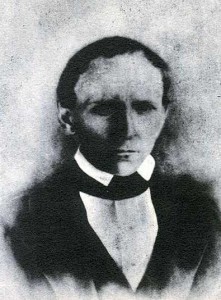
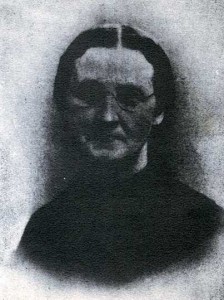 Years ago, I received a CD with a large amount of information on the Knox family, which is my husband, Bob Schulenberg’s mother, Joann Knox’s family. Knowing that these people…dozens of them…are related to you, and knowing how and where they fit in are two very different things. I have been trying to get them connected through Ancestry.com, for years, but really wasn’t able to successfully make the connections until I met John Knox, through his website and through Ancestry.com.
Years ago, I received a CD with a large amount of information on the Knox family, which is my husband, Bob Schulenberg’s mother, Joann Knox’s family. Knowing that these people…dozens of them…are related to you, and knowing how and where they fit in are two very different things. I have been trying to get them connected through Ancestry.com, for years, but really wasn’t able to successfully make the connections until I met John Knox, through his website and through Ancestry.com.
I suppose much of my problem was simply the time constraints, but when you are searching for a specific person without knowing how they fit into your family, but rather only that they do, the search can be endless. They might be the child or grandchild of your great uncle’s daughter. In order to find those connections, you need to go through every person’s children, their children, their 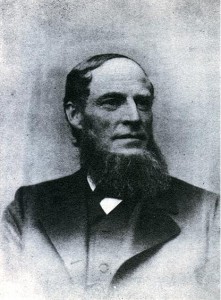
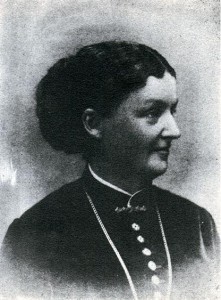 children, and so on. The process can be quite long. That is why making a connection, at any level, with a person who has done research on their family tree becomes one of the most exciting finds in your family history. By following their family back to where you suddenly stumble upon a familiar name from your own tree, you will find yourself face to face…sort of, with a common set of grandparents. Just like that, your family tree has one less mystery in it…or maybe now a new one.
children, and so on. The process can be quite long. That is why making a connection, at any level, with a person who has done research on their family tree becomes one of the most exciting finds in your family history. By following their family back to where you suddenly stumble upon a familiar name from your own tree, you will find yourself face to face…sort of, with a common set of grandparents. Just like that, your family tree has one less mystery in it…or maybe now a new one.
That was exactly how it was for me yesterday, when I finally connected the faces from the CD to the lines in my tree where they belonged. Names like Absolom Knox, who was born in 1738, married Mary Morrison, who was born in 1745, and they had a daughter named Sarah Knox. Sarah then married William Barr, and they had a son named Absolom Knox Barr. Absolom married Abia Foote Wormer, and they had a dughter named Sarah L Barr. Sarah married a man named James Beach…and that takes me in a totally new direction, and one in which they outcome is still unknown to me.

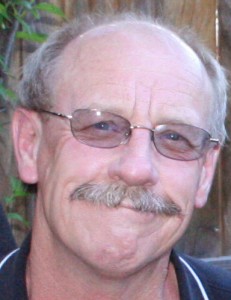 My sister, Caryl Spencer’s first husband was Warren Beach, and together they have a daughter named Andrea and a son named Allen. Now, I know that my husband, Bob Schulenberg and I are tenth cousins on the Knox side of his family, and twelfth cousins on the Leary side of his family. So now the question becomes, is Warren Beach a cousin at some level. It would not be outside the realm of possibilities, you know. I’m sure it will take some time to trace things back to see if my hunch is right, but if it is, then not only would Caryl and Warren be cousins at some level, but Warren and Bob would be cousins at some level. As with many of my stories, this one will mst likely be the continuing saga…or maybe the mystery of the Knox/Beach connection.
My sister, Caryl Spencer’s first husband was Warren Beach, and together they have a daughter named Andrea and a son named Allen. Now, I know that my husband, Bob Schulenberg and I are tenth cousins on the Knox side of his family, and twelfth cousins on the Leary side of his family. So now the question becomes, is Warren Beach a cousin at some level. It would not be outside the realm of possibilities, you know. I’m sure it will take some time to trace things back to see if my hunch is right, but if it is, then not only would Caryl and Warren be cousins at some level, but Warren and Bob would be cousins at some level. As with many of my stories, this one will mst likely be the continuing saga…or maybe the mystery of the Knox/Beach connection.
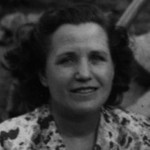 The more I write, the more connected I feel to my Great Aunt Bertha Schumacher Hallgren. I have a feeling that we both used writing for much the same reason…a release of the creative side of ourselves when much of our lives were spent taking care of others. Caregiving is something that is very much an exact science. You have to give the right medicines at the right times, and caring for sick and wounded bodies takes precision and proper methods. There is no room for creativity…other than in the use of items at your disposal to make your job easier, whether it be physical items or the use of your mental abilities to work around a difficult moment in the care of a patient who isn’t ready to give over their independence to someone else, after so many years of being their own person. A caregiver has to follow the instructions of the doctors to the letter in order to insure the improvement and continued health of the patient. And Bertha was a caregiver for many more years than I have been. She knew what it took, and what must be sacrificed.
The more I write, the more connected I feel to my Great Aunt Bertha Schumacher Hallgren. I have a feeling that we both used writing for much the same reason…a release of the creative side of ourselves when much of our lives were spent taking care of others. Caregiving is something that is very much an exact science. You have to give the right medicines at the right times, and caring for sick and wounded bodies takes precision and proper methods. There is no room for creativity…other than in the use of items at your disposal to make your job easier, whether it be physical items or the use of your mental abilities to work around a difficult moment in the care of a patient who isn’t ready to give over their independence to someone else, after so many years of being their own person. A caregiver has to follow the instructions of the doctors to the letter in order to insure the improvement and continued health of the patient. And Bertha was a caregiver for many more years than I have been. She knew what it took, and what must be sacrificed.
Bertha quoted Charles Lamb, who in 1890 wrote “I love to lose myself in other men’s minds.” It might seem a strange thought, to want to get lost in the thoughts of another person, but sometimes their thoughts are so interesting that it is a desirable place to be. Must of us lose ourselves in another man’s mind periodically. Every time you read a good book, your mind pictures the thoughts and images created by the writer. You can’t help yourself really. It’s just how our minds are wired to work.
I have read Aunt Bertha’s journal several times, but it just never gets old. It seems like every time I read it, I discover some new story, whether it is written in the words or simply exists between the lines. Much of what a writer is like can be found living between the lines of the words they write. That is where their feelings live in their writing. Although I don’t recall ever having the opportunity to meet Aunt Bertha, I feel like I know her well. She has poured her heart and soul into her writing. She has been brutally honest about herself. She doesn’t leave out her shortcomings, but puts them into the stories, regardless of how they might make the reader feel about the kind of person she was. Her objective is not to paint herself as a perfect person, but rather to reveal to the reader the true person she was. 
I think many writers would not have the courage to put on paper exactly how they were as a child, worker, caregiver, or person, because they don’t want to show the reader the negative thoughts, or mistakes they have made in their lives. The reality, nevertheless, is that none of us are perfect, but rather human. While Aunt Bertha was not perfect, I truly like the person she was. She reminds me a little bit of myself, and yet inspires me to try to be better than I once was. In her mind, she knows the kind of person she wants to be, and while she failed sometimes, she never quit trying. I find that her mind is truly a good one to lose myself in sometimes.
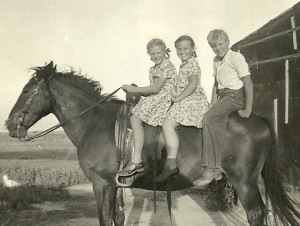 It’s strange that you can look at pictures of people in your family’s history, and somewhere in the back of your mind, you know the names connect, but somehow you don’t connect the people to their parents. While looking through some of the old family pictures from my mother-in-law, Joann Knox Schulenberg’s family, I found pictures of her as a little girl, with two other children, a boy and a girl, who I found out were Richard and Mary Ann Batey. The Batey kids were my mother-in-law’s cousins, and I knew that, but somehow I didn’t connect them with their mother, Bernice Noyes Batey, who I met as an older woman. Then again, I have never met the Batey siblings at all, so maybe that is why they didn’t really connect in my mind. Bernice Batey was my mother-in-law’s mother, Nettie Noyes Knox’s sister, and I did meet her a couple of times. She was a very nice lady, and very sweet, but when you don’t meet the kids at the same time, it can be hard to make the connection. Somehow, the kids end up slipping into that obscure area of almost unknown relatives…until you think about those relationships for a few minutes.
It’s strange that you can look at pictures of people in your family’s history, and somewhere in the back of your mind, you know the names connect, but somehow you don’t connect the people to their parents. While looking through some of the old family pictures from my mother-in-law, Joann Knox Schulenberg’s family, I found pictures of her as a little girl, with two other children, a boy and a girl, who I found out were Richard and Mary Ann Batey. The Batey kids were my mother-in-law’s cousins, and I knew that, but somehow I didn’t connect them with their mother, Bernice Noyes Batey, who I met as an older woman. Then again, I have never met the Batey siblings at all, so maybe that is why they didn’t really connect in my mind. Bernice Batey was my mother-in-law’s mother, Nettie Noyes Knox’s sister, and I did meet her a couple of times. She was a very nice lady, and very sweet, but when you don’t meet the kids at the same time, it can be hard to make the connection. Somehow, the kids end up slipping into that obscure area of almost unknown relatives…until you think about those relationships for a few minutes.
That is exactly what happened with my mother-in-law’s cousins. For a time, I didn’t know those kids were even related at all, until my sisters-in-law told me they were. Then, I just didn’t connect their last name to anyone in particular. Finally, I was looking at a picture of Bob’s grandma, Nettie Knox, with her sister, Bernice Noyes Beaty…who I had always known as Bernice Beaty, it connected. Wow!! These kids were Berniece’s kids. Ok, sometimes I can be a little slow to connect these relationships, but now it became clear just exactly where they fit in.
Family connections are complicated, and even the best genealogy expert could have problems making the connections. Although, maybe if you weren’t 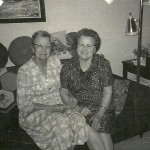 involved as a family member, you would be able to see the relationships clearly. Maybe, you wouldn’t have any pre-conceived idea of where people fit into a family line, if you weren’t somehow emotionally involved with the family.
involved as a family member, you would be able to see the relationships clearly. Maybe, you wouldn’t have any pre-conceived idea of where people fit into a family line, if you weren’t somehow emotionally involved with the family.
I definitely feel a little bit closer to the Noyes side of the family now that I have figured out the connections. I remember meeting Bernice, and thinking that she was such a sweet lady, but then she was Bob’s grandmother’s sister, so being sweet would be right in line with the way the whole family was. I do wish I had known the kids who were such good friends, as well as cousins of my mother-in-law. I’m sure I would have liked them very much too.
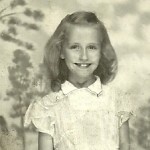 As my sisters and I were going through our parents things a couple of weeks ago, we came across our mom, Collene Byer Spencer’s diary. It was given to her by her sister Virginia and her husband in 1947, when Mom was just eleven years old. As we drew names for the different items we found, I received the diary. My sister, Allyn Hadlock had read a few passages from it, and thought it felt wrong somehow, but since Mom is no longer with us, I think it’s ok to read it. So tonight, I have been doing just that. The diary is a five year diary, and it was written in sporadically from 1947 to 1951. Funny thing about diaries…your well meaning plan to writing in them faithfully every day, always seems to dwindle into once in a great while pretty quickly. Having had a diary myself…wow, I wonder where that got to, and if we will come across it somewhere in all of Mom’s things. What things did I write in there that might be embarrassing? The rambling of a silly little girl…all but meaningless today. Well, all I can say is that I hope we don’t come across it.
As my sisters and I were going through our parents things a couple of weeks ago, we came across our mom, Collene Byer Spencer’s diary. It was given to her by her sister Virginia and her husband in 1947, when Mom was just eleven years old. As we drew names for the different items we found, I received the diary. My sister, Allyn Hadlock had read a few passages from it, and thought it felt wrong somehow, but since Mom is no longer with us, I think it’s ok to read it. So tonight, I have been doing just that. The diary is a five year diary, and it was written in sporadically from 1947 to 1951. Funny thing about diaries…your well meaning plan to writing in them faithfully every day, always seems to dwindle into once in a great while pretty quickly. Having had a diary myself…wow, I wonder where that got to, and if we will come across it somewhere in all of Mom’s things. What things did I write in there that might be embarrassing? The rambling of a silly little girl…all but meaningless today. Well, all I can say is that I hope we don’t come across it.
That said, I do remember my own diary, and much like my mother’s it seems that at the age when a diary becomes so interesting, and all the rage, life always seems to take on a bit of the boring. I suppose that is because nobody’s life can be all bells and whistles every day. At some point, you always find yourself with very little to say about the day’s events. Life’s days aren’t often filled with daily exciting things that are worthy of filling the pages of a diary…at least not when you are eleven. I really wish I had maybe been a little more 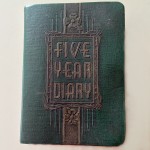 persistent about writing in my diary or a journal in later years though, because I now see the value of such writings.
persistent about writing in my diary or a journal in later years though, because I now see the value of such writings.
I did learn some things about my mother, and even about my dad. Mom met dad when she was just ten years old. She told me that the first time she saw him she thought that he was the most handsome man she had ever seen. Dad was twelve years older than Mom, so when she met him, he would have been 22 years old, and at ten, Mom was just about getting to the age where boys were suddenly interesting, and an older man who was as handsome as my Dad was…well, it must have felt like meeting a movie star. Dad liked Mom right away, but probably not is a romantic way. He was a friend of the family, and so came to visit often. During the next few years it appeared to me that Mom had a bit of a crush on Dad, but maybe tried not to let everyone know that, because of the inevitable teasing that would go along with it. By 1949, Dad’s opinion started to mean more to Mom, and when she cut her hair to look more grown up and he didn’t like it…because Dad has always loved long hair, she was upset, and said, “I got my hair cut, and I like it. Al was mad at me, but he doesn’t have a lease on me, so how I wear my hair is none of his biz!” For his part, Dad told her he was going to grow a beard, and he did. She pretended not to notice. In her early years and even while Dad was coming around a lot, Mom was a bit of a boy crazy girl. I always wondered where I got that from, and now I know. I had a boyfriend from the moment I started school, and it appears that Mom did too, quite a lot.
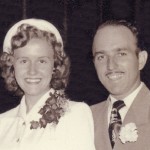 By the time Mom was fifteen years old in 1951, Dad was already sure that she was the girl he wanted to spend the rest of his life with. Their romance reminded me a little bit of Laura Ingalls in the Little House on the Prairie books. Almanzo knew he wanted to marry Laura, and she did too, but her dad said they had to wait to marry until she was eighteen. In Mom’s case, it wasn’t her dad who thought they should wait until she was eighteen, but her. At fifteen years of age, she had to get to know herself first. In the end, they would only wait until she was seventeen, but it did not matter. Theirs was a match made in Heaven, and a love to last a lifetime. And the ramblings of a girl writing in her diary trying to figure out just how life and love worked while written sporadically, were clear to this reader anyway.
By the time Mom was fifteen years old in 1951, Dad was already sure that she was the girl he wanted to spend the rest of his life with. Their romance reminded me a little bit of Laura Ingalls in the Little House on the Prairie books. Almanzo knew he wanted to marry Laura, and she did too, but her dad said they had to wait to marry until she was eighteen. In Mom’s case, it wasn’t her dad who thought they should wait until she was eighteen, but her. At fifteen years of age, she had to get to know herself first. In the end, they would only wait until she was seventeen, but it did not matter. Theirs was a match made in Heaven, and a love to last a lifetime. And the ramblings of a girl writing in her diary trying to figure out just how life and love worked while written sporadically, were clear to this reader anyway.
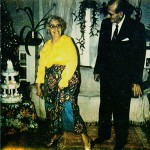 Sometimes, espcially when a couple has been together for a long time, it gets to a place where you can just see the love in their eyes…not to mention, the sheer joy of spending time wth the love of your life. That was how it was with my grandparents, George and Hattie Byer. Everytime he looked at her, you could see the love in his eyes. Grandpa only had eyes for Grandma. Everything she did was a delight to him. If she decided to get a little goofy and dance around the living room, Grandpa thought is was the coolest thing she had ever done…but then, he felt that way about everything she did. That is the I only have eyes for you kind of love.
Sometimes, espcially when a couple has been together for a long time, it gets to a place where you can just see the love in their eyes…not to mention, the sheer joy of spending time wth the love of your life. That was how it was with my grandparents, George and Hattie Byer. Everytime he looked at her, you could see the love in his eyes. Grandpa only had eyes for Grandma. Everything she did was a delight to him. If she decided to get a little goofy and dance around the living room, Grandpa thought is was the coolest thing she had ever done…but then, he felt that way about everything she did. That is the I only have eyes for you kind of love.
Through the years, we saw that loving look on Grandpa’s face. Grandpa was sixteen years older than Grandma, not an uncommon thing for the times, and I think he was so amazed that he had found such a beautiful girl, and that she wanted to marry him. I think he just couldn’t believe how blessed he was. Of course, Grandma was pretty smitten with him too. Grandma was a short girl…standing five feet tall…in her tall years, and Grandpa stood over six feet. He was her tall, dark and handsome man, and she was very proud of him. You see, she only had eyes for Grandpa too. Most of the time, that is the way it goes. The feelings are usually mutual.
Grandpa was the bread winner of the family, and Grandma was the keeper of the home and the children. Grandma never learned how to drive. She just didn’t see the need for it, and I suppose Grandpa thought that was ok, but I’ll bet that if she had wanted to learn to drive, he would have taught her how. I think she always 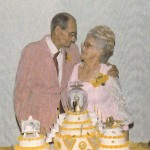 felt like she had all she needed right there at home, and anywhere she needed to go, he could take her. She would have had to pack up all the kids to go anywhere anyway, so maybe it was just easier to stay at the house.
felt like she had all she needed right there at home, and anywhere she needed to go, he could take her. She would have had to pack up all the kids to go anywhere anyway, so maybe it was just easier to stay at the house.
Whatever the reason, my grandmother, who was happy as a clam, had to display that happiness sometimes, and when the urge to kick up her heels struck her, she didn’t hold back. To Grandpa’s delight, she would do something outrageous like strike a favorite pose or dance a jig. Then Grandpa, who was always mesmerized with his beautiful bride, would grin from ear to ear. It didn’t matter what Grandma was doing, because no matter what it was, he would always only have eyes for grandma.
 Lately, I have been looking in Ancestry.com, at immigration records for many of my ancestors. As I looked at the different ships they sailed on and the different locations they came from, I began to wonder about what it was really like to immigrate back them. I decided to do some research on that subject, and I was amazed at some of what I found.
Lately, I have been looking in Ancestry.com, at immigration records for many of my ancestors. As I looked at the different ships they sailed on and the different locations they came from, I began to wonder about what it was really like to immigrate back them. I decided to do some research on that subject, and I was amazed at some of what I found.
Of course, the biggest obstacle they faced was the cost…especially for a family. What doesn’t sound like much to us today, was really a lot of money back in the 1800s, and before. My great grandfather, Carl Schuhmacher spent seven years saving the $50.00 that it cost for one person to go. Many times, the whole family would work to send one person over so they could see if the opportunities were really there, and then that person would work t pay for the rest of the family to come.
For people who had to travel in steerage class, the journey was going to be a rough one. There was no limit to the number of steerage tickets sold, and the cost was usually $30.00 per ticket, which tells me that maybe my great grandfather had not traveled in steerage class…which is a relief to me after what I have read. Since there was no limit to the steerage tickets sold, the people were packed into the steerage area like cattle. The cost to feed each one was about sixty cents a day, so they could potentially make a net profit of $45,000 to $60,000 for each crossing. This was money made at the expense of the health, welfare, and even lives of those steerage passengers…a fact that I find shocking to say the least!!
Even when the immigrant wasn’t in steerage, the rough weather often made everyone sick. I don’t think that ships back then had some of the stabilizing features ships have today, and since they were smaller, they were probably tossed around more. Not good if you get sea sick…or even if you normally don’t.
Immigrants were told to be at the docks a day ahead of the departure date, because they had to be examined by American doctors before they were allowed to board the ship. I have no idea where they waited if they didn’t get examined the day before they sailed. I also have to wonder if they had to be examined again when they arrived here, because so many of them were sick on the ship that I would still think they brought disease to America.
Arrival in America didn’t necessarily mean they were set either. Because of language differences and strange sounding names, they were often subject to verbal abuse and discrimination. To fit in they would need to learn 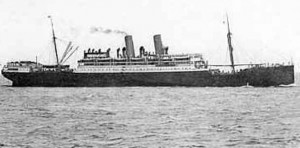 English…something I do agree with, although I don’t agree with discrimination or verbal abuse…or any other kind of abuse. I think they needed someone to teach them, without belittling them. Most wanted to fit in, but didn’t know how to learn English, or simply didn’t have a way to learn it.
English…something I do agree with, although I don’t agree with discrimination or verbal abuse…or any other kind of abuse. I think they needed someone to teach them, without belittling them. Most wanted to fit in, but didn’t know how to learn English, or simply didn’t have a way to learn it.
Any time you make a decision to move to another country, it is a life changing decision, but in those days, it was a much bigger change than it is these days. Had it not been for necessity, due to famine and poverty in their ow country, I have to wonder just how many people would have taken the risk.
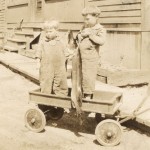 As a young boy, my uncle, William Malrose Spencer II “Uncle Bill” remembers his mother, Anna Schumacher Spencer talking about That Black Book. The way she spoke about it must have made him understand that somehow this book was really important, because he never forgot about it. He called it That Black Book, because his mother had called it That Black Book. He figured that was as good a name as any. Uncle Bill writes, “The year was 1937, and we lived on a farm exactly one half mile West and exactly one half mile North of Holyoke, Minnesota, which was about 20 miles Southwest of Duluth.” He is so meticulous when it comes to the details of the family history…a fact that makes every detail so clear to the reader.
As a young boy, my uncle, William Malrose Spencer II “Uncle Bill” remembers his mother, Anna Schumacher Spencer talking about That Black Book. The way she spoke about it must have made him understand that somehow this book was really important, because he never forgot about it. He called it That Black Book, because his mother had called it That Black Book. He figured that was as good a name as any. Uncle Bill writes, “The year was 1937, and we lived on a farm exactly one half mile West and exactly one half mile North of Holyoke, Minnesota, which was about 20 miles Southwest of Duluth.” He is so meticulous when it comes to the details of the family history…a fact that makes every detail so clear to the reader.
The book came to be about the time of World War I, when his dad, my Grandpa Allen Luther Spencer had gone to Arapahoe and Thomas, Oklahoma to visit his Uncle Luther and his Uncle Cornelius “Neal” and their families.  The uncles had homesteaded in the area in 1895. When he came back, he brought with him the family historical information that Grandma Anna Schumacher Spencer filled the first seven pages of That Black Book with. Uncle Bill believes that most of the information came from his Great Uncle Luther, and then recalls that it was at that time that his own interest in the family history started…never to end.
The uncles had homesteaded in the area in 1895. When he came back, he brought with him the family historical information that Grandma Anna Schumacher Spencer filled the first seven pages of That Black Book with. Uncle Bill believes that most of the information came from his Great Uncle Luther, and then recalls that it was at that time that his own interest in the family history started…never to end.
Being a very meticulous man, who checked his facts as carefully as possible, Uncle Bill became a little frustrated when it appeared that there were errors in the information found in That Black Book. Of course, the only error was that in writing down the history, Christopher Spencer’s father was listed as his brother, making the birth years look like an impossibility. Uncle Bill is a smart man, however, and he figured that problem out right away. As I said, he was meticulous. He just couldn’t let a situation rest until he fixed the error in it. The really amazing thing about that is that he did his fixing without the benefit of a computer and the internet. His 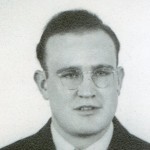 work always involved trips to different places to spend hours going through archives in libraries and government records offices.
work always involved trips to different places to spend hours going through archives in libraries and government records offices.
While That Black Book did contain errors, it really served its main purpose anyway, in that it peaked the interest of a young boy with an amazing amount of determination. Through the years Uncle Bill would build on, correct, and give away copies of the family history to any and all of his relatives who were interested. He is responsible for many additional family historians coming up the ranks in the family, myself included. And it all started when a little boy became interested in the family history information contained in That Black Book.
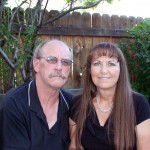 While little is known about his mother, Susan Francis Spencer Cheshire, my husband, Bob’s second great grand uncle, James Riley Cheshire was a rather well known man…at least in Jefferson County, Tennessee. As a young man of only 14 years, he vividly remembers some of the tragedies of the Civil War, of which his family was not a part, but because of where they lived, they were suspected of being a part of the rebel sympathizers. The old Baker place was where they lived, and the Bakers were hated by the Union soldiers for their loyalty to the Rebel cause. The family had moved there when Mr Baker decided to move to a place that was closer to his son-in-law’s place. So, the Cheshires into it because it was a bigger, very nice log home.
While little is known about his mother, Susan Francis Spencer Cheshire, my husband, Bob’s second great grand uncle, James Riley Cheshire was a rather well known man…at least in Jefferson County, Tennessee. As a young man of only 14 years, he vividly remembers some of the tragedies of the Civil War, of which his family was not a part, but because of where they lived, they were suspected of being a part of the rebel sympathizers. The old Baker place was where they lived, and the Bakers were hated by the Union soldiers for their loyalty to the Rebel cause. The family had moved there when Mr Baker decided to move to a place that was closer to his son-in-law’s place. So, the Cheshires into it because it was a bigger, very nice log home.
Soon after moving there, James recalls the day when he saw one of the Baker boys and Mr Richie, a brother-in-law, shot by the Union Soldiers. The bodies were taken to the Cheshire house to be prepared for burial. As they were getting ready to place them in their coffins, Union soldiers showed up and searched the house again, but they didn’t do anything to the bodies. James saw the soldiers march old man Baker into the woods, and heard the three shots they fired into him. After they left, James and his five year old sister, Louise Cheshire ran out to the woods and spend several hours guarding him so that the hogs didn’t get his body before the coffin maker could help move him. The Bakers had been so hated by the Kingston Militia that it was decided that their house would be burned. They ordered the Cheshires to get all of their goods out and burned the house down. There were many harrowing experiences that James recalls from the Civil War days, and maybe it was all the death he saw then that prompted him to begin carpentry work, including coffin making. He was the first person in the county to make a flat top coffin. I can’t say why the flat top coffin was so important, but apparently it was the latest thing. The people really liked them, and they had a hard time keeping them in stock. James was always considered a wise man. He felt very strongly that evey town needed a church. He joined the Cottage Grove 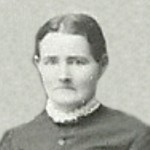 Baptist Church in 1871, and he helped organize the Baptist Church of Cowgill in 1888. He was made deacon of the church in 1893. He also worked in banking, and became a judge at one time.
Baptist Church in 1871, and he helped organize the Baptist Church of Cowgill in 1888. He was made deacon of the church in 1893. He also worked in banking, and became a judge at one time.
My main interest in James comes from the fact that he is related to both sides of my family. His dad is an ancestor of the Knox side of Bob’s family, and his mother is a Spencer, and related to my dad’s side of my family. Unfortunately there seem to be no pictures of James…a fact that I find very sad indeed. Nevertheless, he is a connector to both my families, and was a very well known and respected man who went through so pretty awful things as a young man, and handled them quite well in my opinion. And he was the brother of Bob’s grandmother, Sarah Cheshire Knox.

 When you read through the personal journal of another person’s life, you must be prepared for the many emotions that life can produce in people. My great aunt, Bertha Schumacher Hallgren was an amazing woman, as was her younger sister, Elsa Schumacher Lawrence. They spent years working in a man’s world, and being successful at it…in fact out working them and being capable of using machinery the men couldn’t. They were considered so invaluable that the companies they worked for tried really hard not to give them any time off, as the place didn’t do so well when they were gone. The work was so emotionally draining, that the only release for them sometimes came in the form of bitter tears. Nevertheless, times were tough during the depression years, and you didn’t just walk away from a job, because the going got tough.
When you read through the personal journal of another person’s life, you must be prepared for the many emotions that life can produce in people. My great aunt, Bertha Schumacher Hallgren was an amazing woman, as was her younger sister, Elsa Schumacher Lawrence. They spent years working in a man’s world, and being successful at it…in fact out working them and being capable of using machinery the men couldn’t. They were considered so invaluable that the companies they worked for tried really hard not to give them any time off, as the place didn’t do so well when they were gone. The work was so emotionally draining, that the only release for them sometimes came in the form of bitter tears. Nevertheless, times were tough during the depression years, and you didn’t just walk away from a job, because the going got tough.
It wasn’t the years of hard work that seemed to be the most severe blow to Bertha, but rather the life changing moment when her sister, Elsa decided after all the years of caregiving for their parents, now both gone home to Heaven, to marry a man who was a widower ready to retire. Bertha and Elsa had made the decision, probably subconsciously, to set aside their hopes for a family and a home of their own at a very young age. They were the youngest of their parents seven children, and while the other children had married and left home, comfortable in the knowledge that the two youngest sisters were still there taking care of their aging parents, the girls knew that no one would be left if they married too. After their parents passing, the girls lived together for a number of years, before Elsa met Frank Lawrence and became engaged.
Bertha likens the situation to divorce. She had lived with her sister for 40 years, and the separation was torturous. To make matters worse, their older sister, Mina, who had always lived close, made the decision to move to Colorado to be near her daughter, Paula, while her husband, John Spare went into the CBees during World War II. Bertha talked about dividing the things she and Elsa had in the home, and looking for a smaller apartment that she could afford on her own…and she talked about the tears. For the first time in her life, Bertha was going to be alone, and she didn’t like or want this, at all.
I know how she feels to a degree. I am not alone, because I have much family, and of course, my husband, Bob Schulenberg in my life. Nevertheless, after a parent, or other patient you have cared for goes to Heaven, or even gets better, and goes about their own lives, the caregiver can find themselves at loose ends. They wonder who they are if they are not a caregiver. Then, as in Bertha’s case, the only companionship she had every really known is gone too. She felt like she had just been placed on top of a cliff, and the only way out was to fall, and the consequences of that were just as bad as staying put.
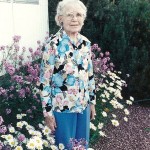
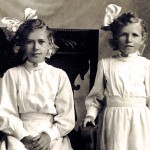 In the end, Bertha would move to Colorado with Mina and Paula, and she would meet the man she would marry. The marriages of Bertha and Elsa would not last long, because their husbands both died after a short marriage and much happiness. The girls regrouped, and once again became companions for each other. It was as if it was meant to be…as if they had never been apart. Their lives had always been intertwined, and their golden years would be spent together in their new home in Boulder, Colorado…until Bertha passed away in 1984, leaving Elsa alone until her passing in 1992.
In the end, Bertha would move to Colorado with Mina and Paula, and she would meet the man she would marry. The marriages of Bertha and Elsa would not last long, because their husbands both died after a short marriage and much happiness. The girls regrouped, and once again became companions for each other. It was as if it was meant to be…as if they had never been apart. Their lives had always been intertwined, and their golden years would be spent together in their new home in Boulder, Colorado…until Bertha passed away in 1984, leaving Elsa alone until her passing in 1992.

